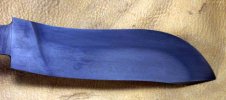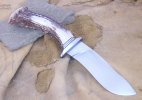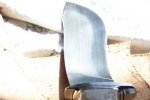- Joined
- Aug 21, 2001
- Messages
- 397
Since the big change I can't figure how to find my old thread, so here is a reply to it since I said I would.
My orginal question was if the unusual figuring/banding/ damascus look I saw after etching an 0-1 blade was good or bad. I cleaned it up better with 1200 grit, and all the wierdness disappeared.
As I stated in my other thread, the edge passed the brass rod test fine and it also chopped spruce well for the blade size. I did some cutting tests on manila rope, and it did better than an ATS-34 blade at RC 60 of the same size. The grind geometry is different though, which of course invalidates everything, but does let me know that at least the 0-1 heat treat seems O.K. .
You can't see the hardening line unless the light is just right, as demonstrated in the pics below. Hamon pic is just out of etch and rubbed down with steel wool, 0-1wapati pic is finished knife and 0-1zoneharden shows the hardened zone after finishing in sunlight.
Clint Chisan
www.chisanknives.com
My orginal question was if the unusual figuring/banding/ damascus look I saw after etching an 0-1 blade was good or bad. I cleaned it up better with 1200 grit, and all the wierdness disappeared.
As I stated in my other thread, the edge passed the brass rod test fine and it also chopped spruce well for the blade size. I did some cutting tests on manila rope, and it did better than an ATS-34 blade at RC 60 of the same size. The grind geometry is different though, which of course invalidates everything, but does let me know that at least the 0-1 heat treat seems O.K. .
You can't see the hardening line unless the light is just right, as demonstrated in the pics below. Hamon pic is just out of etch and rubbed down with steel wool, 0-1wapati pic is finished knife and 0-1zoneharden shows the hardened zone after finishing in sunlight.
Clint Chisan
www.chisanknives.com



